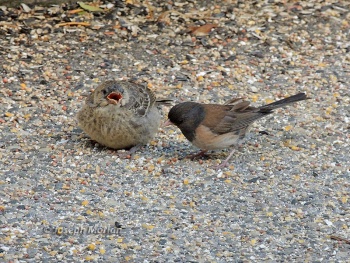- Molothrus ater
Identification
Male: 7.5-8.7 in (19-22 cm); female: 6.3-7.9 in (16-20 cm)
- Finch-like bill
Male – glossy black plumage (sometimes a blue-green sheen can be seen), rich brown head, dark eye
Female – brown plumage, paler on the head and underparts, dark bill and eye
Juvenile – similar in color to female, but with streaking on breast and paler bill
Similar Species
Female Shiny Cowbird is similar to female, but has a longer, more pointed bill. Female Brewer's Blackbird is much larger with longer bill and darker body.
Variations
Populations in the Far West average smaller than those elsewhere.
Distribution

Photo © by Joseph Morlan
Pacifica, California, USA, 18 June 2015
Canada, USA and Mexico
Canada: Alberta, British Columbia, Manitoba, New Brunswick, Newfoundland, Labrador, Nova Scotia, Northwest Territories, Ontario, Prince Edward Island, Quebec
USA: New England, Alaska, Alabama, Arkansas, Arizona, California, Colorado, Connecticut, District of Columbia, Delaware, Florida, Georgia, Iowa, Idaho, Illinois, Indiana, Kansas, Kentucky, Louisiana, Massachusetts, Maryland, Maine, Michigan, Minnesota, Missouri, Mississippi, Montana, North Carolina, North Dakota, Nebraska, New Hampshire, New Jersey, New Mexico, Nevada, New York, Ohio, Oklahoma, Oregon, Pennsylvania, Rhode Island, South Carolina, South Dakota, Tennessee, Texas, Utah, Virginia, Vermont, Washington, Wisconsin, West Virginia, Wyoming
Mexico: Baja California, Tamaulipas, Oaxaca, Los Coronados Islands
Taxonomy
Subspecies

Photo © by Stanley Jones
Union Bend Road, Mumford, Robertson County, Texas, USA, 16 October 2022
This is a polytypic species which consists of four subspecies[1]:
- M. a. artemisiae:
- Southern coastal Alaska to south-western US; migrates to Baja California and southern Mexico
- M. a. obscurus:
- South-western US to Guerrero and northern Tamaulipas; migrates to southern Baja California Sur and Oaxaca
- M. a. ater:
- M. a. californicus:
- Southern California to northern Baja California and Los Coronados Islands (off north-western Baja California)
Habitat
Farmland, foreste edges, suburbs.
Behaviour
Breeding
Cowbirds are brood parasites; the female removes one egg from the host nest and lays one of her own. Four to five white, brown speckled eggs are laid, one at a time.
Vocalisation
Song: A liquid, bubbly gurgle followed by an upslurred, high-pitched whistle (given during display).
Call: check or a rattle.
References
- Clements, J. F., T. S. Schulenberg, M. J. Iliff, T. A. Fredericks, J. A. Gerbracht, D. Lepage, S. M. Billerman, B. L. Sullivan, and C. L. Wood. 2022. The eBird/Clements checklist of Birds of the World: v2022. Downloaded from https://www.birds.cornell.edu/clementschecklist/download/
- Lepage D. (2020) Brown-headed_Cowbird in Avibase - The World Bird Database. Retrieved 4 April 2020
- Lowther, P. E. (2020). Brown-headed Cowbird (Molothrus ater), version 1.0. In Birds of the World (A. F. Poole and F. B. Gill, Editors). Cornell Lab of Ornithology, Ithaca, NY, USA. https://doi.org/10.2173/bow.bnhcow.01
- Fraga, R. & Garcia, E.F.J. (2020). Brown-headed Cowbird (Molothrus ater). In: del Hoyo, J., Elliott, A., Sargatal, J., Christie, D.A. & de Juana, E. (eds.). Handbook of the Birds of the World Alive. Lynx Edicions, Barcelona. (retrieved from https://www.hbw.com/node/62295 on 5 April 2020).
- Jaramillo, A. & Burke, P. (1999) New World Blackbirds: The Icterids. Princeton Univ. Press, Princeton, New Jersey. ISBN 0-69100-680-6
- Wolf, L. (1987) Host-Parasite Interactions of Brown-headed Cowbirds and Dark-eyed Juncos in Virginia. Wilson Bulletin 99:338-350. PDF
Recommended Citation
- BirdForum Opus contributors. (2025) Brown-headed Cowbird. In: BirdForum, the forum for wild birds and birding. Retrieved 16 May 2025 from https://www.birdforum.net/opus/Brown-headed_Cowbird
External Links
GSearch checked for 2020 platform.1






